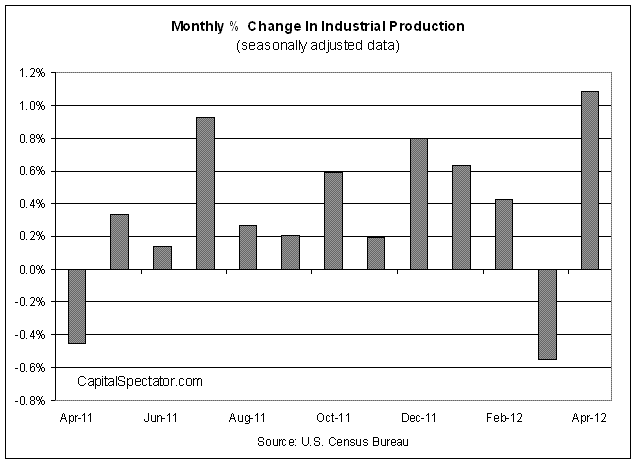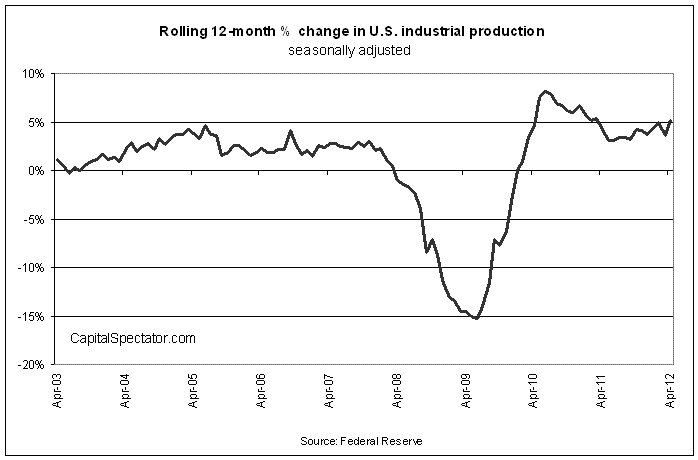If you’re looking for evidence that recession risk is rising, you won’t find it in yesterday’s update on industrial production, which surged 1.1% in April—the biggest monthly rise since December 2010. The cycle may drag us down in the months ahead, but industrial production is putting up a pretty good imitation of swimming against the tide.
The other big economic news yesterday came from housing, which suggests that the modest mending rolls on. Housing starts rose a bit last month, although newly issued building permits retreated. The trend in both cases still looks favorable, albeit mildly. But slow healing has been the narrative all along for housing and the numbers du jour don’t change that view.
The drama, however, is clearly in industrial production, and for all the right reasons. Let’s start by looking at the monthly percentage changes. As you can see, April witnessed a strong revival in this series, which is considered to be on the short list of proxies for the broad economy. The caveat is that the revisions lately have been relatively large and so yesterday’s good news may evaporate next month. But given the numbers in hand, it’s a bit tougher to argue that the economy is headed for trouble.
The stronger evidence for seeing the macro glass half full comes from looking at industrial production’s one-year percentage change, which moved up to a robust 5.2% increase. If and when a new recession is imminent, history suggests we'll see a much lower growth rate. To the extent that some analysts have been using industrial production’s weakening annual pace of late to warn of a new slump ahead, yesterday’s stats throw a wrench into that machine.
Any one number must be taken with a grain of salt, of course. Indeed, there are still several reasons to remain cautious about the business cycle, including the slowdown in payrolls growth last month and the ongoing deceleration in the growth rate for personal income.
But yesterday’s industrial production news suggests it’s still too early to give up on growth, a message we heard two weeks ago in April’s IMN Manufacturing report.
This is a good time to emphasize that no one should confuse predicting a new recession at this point with making the case that a new downturn has started based on a preponderance of smoking guns in real time. There may be a downturn lurking in the near-term future, but that’s still a debatable forecast, and one with slightly less statistical support in the wake of the industrial production update. Everything may change tomorrow, but in the meantime you can’t rush the future. It's all a matter of how much confidence you're comfortable with when perusing the numbers. As such, the question I posed earlier in the week is still very much alive and kicking: Recession Or More Slow Growth?
Yesterday's industrial production report brings "more positive U.S. economic news pointing to continued moderate growth," Jennifer Lee, a senior economist at BOMB Capital Markets, tells Reuters.
“Things are looking brighter than they were a few months ago,” opines Millan Mulraine, senior U.S. strategist at TD Securities via Bloomberg. “Auto production is doing well because consumers are buying vehicles, and consumers are buying vehicles because they feel more positive about their job prospects.”
If there’s a good reason to think otherwise, it’ll be conspicuous in the numbers. Until then, gloom is still a forecast. It may be an informed forecast, and it may even be right. No harm done, assuming you distinguish forecasting from profiling the economy with the data as it arrives.
- English (UK)
- English (India)
- English (Canada)
- English (Australia)
- English (South Africa)
- English (Philippines)
- English (Nigeria)
- Deutsch
- Español (España)
- Español (México)
- Français
- Italiano
- Nederlands
- Português (Portugal)
- Polski
- Português (Brasil)
- Русский
- Türkçe
- العربية
- Ελληνικά
- Svenska
- Suomi
- עברית
- 日本語
- 한국어
- 简体中文
- 繁體中文
- Bahasa Indonesia
- Bahasa Melayu
- ไทย
- Tiếng Việt
- हिंदी
Industrial Production Rebounds Sharply In April
Published 05/17/2012, 12:34 AM
Updated 07/09/2023, 06:31 AM
Industrial Production Rebounds Sharply In April
Latest comments
Loading next article…
Install Our App
Risk Disclosure: Trading in financial instruments and/or cryptocurrencies involves high risks including the risk of losing some, or all, of your investment amount, and may not be suitable for all investors. Prices of cryptocurrencies are extremely volatile and may be affected by external factors such as financial, regulatory or political events. Trading on margin increases the financial risks.
Before deciding to trade in financial instrument or cryptocurrencies you should be fully informed of the risks and costs associated with trading the financial markets, carefully consider your investment objectives, level of experience, and risk appetite, and seek professional advice where needed.
Fusion Media would like to remind you that the data contained in this website is not necessarily real-time nor accurate. The data and prices on the website are not necessarily provided by any market or exchange, but may be provided by market makers, and so prices may not be accurate and may differ from the actual price at any given market, meaning prices are indicative and not appropriate for trading purposes. Fusion Media and any provider of the data contained in this website will not accept liability for any loss or damage as a result of your trading, or your reliance on the information contained within this website.
It is prohibited to use, store, reproduce, display, modify, transmit or distribute the data contained in this website without the explicit prior written permission of Fusion Media and/or the data provider. All intellectual property rights are reserved by the providers and/or the exchange providing the data contained in this website.
Fusion Media may be compensated by the advertisers that appear on the website, based on your interaction with the advertisements or advertisers.
Before deciding to trade in financial instrument or cryptocurrencies you should be fully informed of the risks and costs associated with trading the financial markets, carefully consider your investment objectives, level of experience, and risk appetite, and seek professional advice where needed.
Fusion Media would like to remind you that the data contained in this website is not necessarily real-time nor accurate. The data and prices on the website are not necessarily provided by any market or exchange, but may be provided by market makers, and so prices may not be accurate and may differ from the actual price at any given market, meaning prices are indicative and not appropriate for trading purposes. Fusion Media and any provider of the data contained in this website will not accept liability for any loss or damage as a result of your trading, or your reliance on the information contained within this website.
It is prohibited to use, store, reproduce, display, modify, transmit or distribute the data contained in this website without the explicit prior written permission of Fusion Media and/or the data provider. All intellectual property rights are reserved by the providers and/or the exchange providing the data contained in this website.
Fusion Media may be compensated by the advertisers that appear on the website, based on your interaction with the advertisements or advertisers.
© 2007-2024 - Fusion Media Limited. All Rights Reserved.
